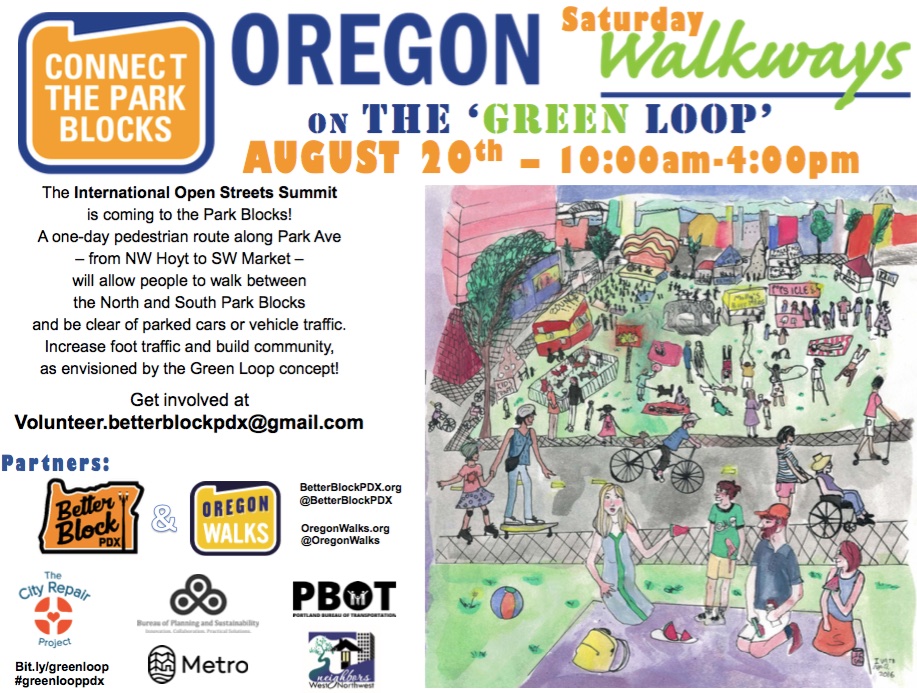
The crew that brought us the 3rd Avenue plaza, Better Broadway and Better Naito are about to embark on yet another ambitious project: this Saturday Better Block PDX will connect the north and south Park Blocks to create a one-mile stretch of carfree streets and plazas.
It’s an effort in partnership with the City of Portland and nonprofit Oregon Walks to offer a sneak peak of the future “Green Loop” project. And like their previous efforts (which have been very successful), organizers hope to plant seeds with Portlanders that this is how downtown could — and should — always look and feel.
Or, as organizers say in the official press release, it’ll be, “a one-day open street demonstration project intended to inspire us all to reimagine our downtown streets as carfree, people-first environments.”
In addition to 26 blocks of open streets where people can walk and role undeterred by the usual dominance of motorized vehicles, this event will also create a new public plaza on SW Ankeny between Broadway and Park. This little alleyway between Bailey’s Taproom and Mary’s Club is similar to the one adjacent to Voodoo just a few blocks away. That is, before it became a carfree promenade and plaza.
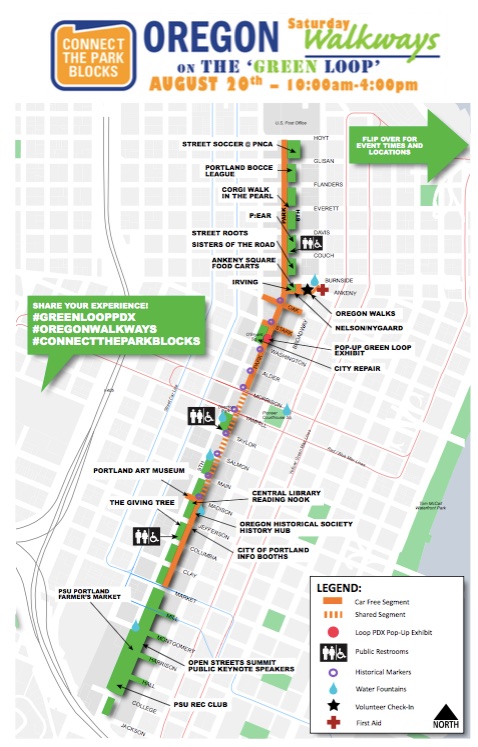
You could also think of Saturday’s event as a mini Sunday Parkways.
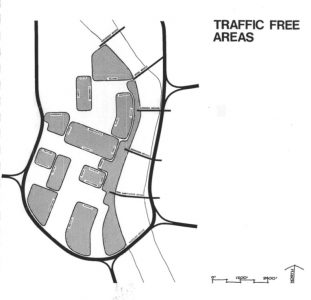
While organizers are certainly looking toward the future, their idea to reduce car use in this part of downtown goes way back in Portland planning history. 44 years back. The 1972 Downtown Plan (PDF) as adopted by City Council said we should, “develop major pedestrian-bicycle circulation along the south park blocks,” and “close Park and Ninth avenues to vehicular traffic, except for service access.”
We haven’t exactly lived up to that plan, but on Saturday we’ll get closer than ever. Park Avenue will be carfree from 8:00 am to 4:00 pm between NW Hoyt and SW Morrison and from SW Main to Market.
The event officially opens at 10:00 am and there will be a ceremonial kickoff at 11:00 am on SW Ankeny at Broadway. It also coincides with the International Open Streets Summit which begins tomorrow and runs through Sunday at Portland State University.
Full details at BetterBlockPDX.org.
— Jonathan Maus, (503) 706-8804 – jonathan@bikeportland.org
Our work is supported by subscribers. Please become one today. You can also make a one-time donation here.


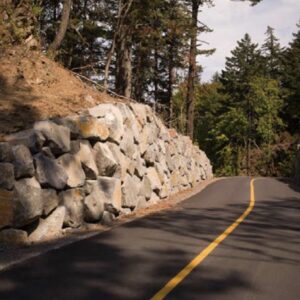
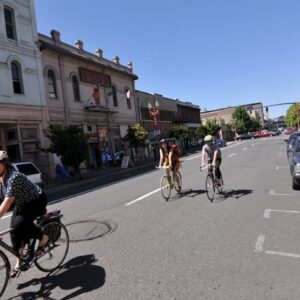
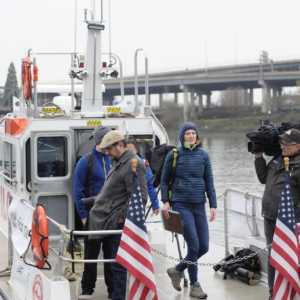
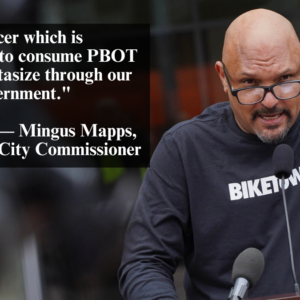
Thanks for reading.
BikePortland has served this community with independent community journalism since 2005. We rely on subscriptions from readers like you to survive. Your financial support is vital in keeping this valuable resource alive and well.
Please subscribe today to strengthen and expand our work.
Hard to believe that it’s taken this long to get to this point. Will all those areas marked in grey on that 1972 map become truly traffic free? This event is a step in the right direction!
How are they handling the cross-town traffic on Broadway?
Sorry, I meant Burnside.
Motorists must dismount to cross.
LIKE!
I always thought they were called the “Park” Blocks because they effectively function as a linear parking lot. 😉
It is absolute insanity how much space is given to private automobiles on what is supposed to be the showcase cultural district of Portland. Using the Park Blocks as space for people is a much better alternative. We’ve created this car culture upon ourselves, and we can and must undo it ourselves.
You wanna undo car culture? Undo how easy it is to own and drive a car. Undo free on-street parking. Instead of giving two-person carpools their own freeway lane, require single-occupancy vehicles to pay a surcharge during peak hours. Instead of suggesting that we require bicycle insurance for all riders, enforce existing traffic laws and stiffen the penalties for motorists who injure someone while operating their vehicles.
Honestly, the pedestrian-only zones are nice and sort of cute; but if all they are is temporary (or if they can be removed by people demanding more on-street parking) then all they’ll remain is cute. I’m tired of cute. I want real.
Exactly, the fact is that when you add up all the real costs and externalities such as pollution, drainage problems, auto accident deaths and injuries, land taken away from housing and nature, mental illness caused by driving rage, most of the budgets of fire, police and public works departments etc. etc. driving an automobile is massivly subsidized. All we need to do is build the “real” costs of driving an automobile in to its costs in the form of gas taxes, license fees and tolls and it will drop by 80% because it will not be affordable by most people. We are only fooling ourselves that it is affordable now because we pass the real costs on to others, the planet and our children.
Totally agree. I’m tired of these “experimental” car-free spaces. Space for people was the norm for all of human existence save for the last hundred or so years. It’s time to stop letting metal machines intrude on our public spaces! Every single one of our supposedly car-free spaces (such as Waterfront Park, Pioneer Square, etc.) comes with the caveat that cars are allowed when needed. Even our supposed “low-car” facilities don’t do much to discourage free reign by drivers.
City Council needs to act on this now: permanent bans on cars from and adjacent to our parks, diverters on bikeways at every collector street as well as every few blocks, and truly separated bicycle facilities – not just more paint. Our city leadership loves to talk a big game about these “innovative” solutions, but refuse to acknowledge this need in our budget.
Would it be fair to say that the “experimental” things led to parking-protected bike lanes on SW 2nd and 3rd Avenues? Were those not approximately the sort of thing you like? Better Block makes more change than carping on Bike Portland, but which is easier?
I think we have a fair chance of seeing something happen on SW Naito Parkway. Again, Better Block.
As Ted B. says below, if you’d like fewer cars on the Park blocks, get yourself down there this Saturday and inhabit.
There is no parking-protected bike lane on 3rd Avenue.
The time for experimentation is over. We know what works, we’re just afraid to make it permanent.
Who is we? Lots of us don’t know any such thing, but some of us know what we like. And, OK, buffered bike lane knocking out a full lane formerly available to any motor vehicle. I think of those things on 2nd and 3rd Ave. as experiments in themselves, and if I must have one or the other I’ll take the buffered lane on third as having better pavement and fewer surprises than the 2nd Ave. trough. To quote a local writer, “They know it’s crap”, crap served up cold.
We as in the collective knowledge of society. Well-designed bike infrastructure is able to be seen overseas – in fact, the city has a program to send PBOT employees to Copenhagen for design ideas! Cities in North America have been building well-designed bike infrastructure for a while now, too. Thriving car-free spaces can be seen in many American cities. There is no longer a need to “experiment” with designs proven to work elsewhere. The only constraint we face here is political will.
Yet, in Portland, we are still acting as if these ideas are new, radical, and untested.
So by implementing the ideas you’re suggesting, would everyone out in the suburbs and in Portland’s close in neighborhoods be deciding not to be come to town because parking doesn’t exist, or costs too much, or they can’t use a less congested lane on the freeway because their vehicle isn’t full to capacity with people?
Can they instead, all ride a bike to town, or ride mass transit?
Were the city to approve construction, quadrupling, maybe even increasing tenfold, the amount of residential housing adjoining streets established to be ‘carfree’ streets, would there be a need for people living in that housing, to have a car?
Portland’s urban camping community is eagerly awaiting a more pedestrian and bike-friendly Park Blocks.
Got an idea for making up the revenue the city will claim it will lose if it eliminates parking along the Park Blocks?
Use of real estate, as represented by public streets along the park blocks may more influenced by the business culture, than they are the ‘car culture’. The business culture, and influence it can have on city planning, is why it seems the originally conceived continuous series of park blocks was never realized. Decades ago, the city goofed, and let some buildings be erected on blocks designated as Park Blocks, then failed to stop the mistake from proceeding further.
Anyway…nice thing that Better Block PDX has put together. It’s good for the blocks to be connected, even on a temporary basis, to give people some idea of what it might have been to have a continuous chain of city blocks from north to south.
Yeah, charge $20/hour to park downtown.
I guess I should have specified ‘good idea’, because rejoinders like “…charge $20/hour to park downtown.”, aren’t good ideas. Not if people really are serious about coaxing the city to get curbside car parking off the park blocks.
Maybe the city could hit up the food cart businesses to make up revenue lost if it were to remove curbside parking in the park blocks; if they pay a tax or fee now, increase it, or add an addtional ‘support car free’ fee.. Or…(and I personally wouldn’t like this idea, because I don’t like food carts, or how they’d likely look in that setting.) the city could eliminate all of this parking, and consider leasing some of the area next to the curb, to food cart operators.
Charging $20/hour to park downtown would get people to seriously reconsider their transportation choices, which is the whole point of my proposal.
This is a great idea that should have been implemented years ago, instead, the city doubled the parking capacity on the Park Blocks when the north-south light rail got built (there used to only be parking on one side of the street on the South Park Blocks). The Park Blocks have so much potential for non-motorized users, but ever since the north-south light rail was built I think of them as the parking blocks instead. Now if they’d only repave the South Park Blocks, the pavement is in terrible condition.
As an insufferable skeptic, I can’t find fault with this idea.
It has weaknesses, of course, but Burnside and the Broadway Bridge connection are issues well out of scope.
Am I imagining things or did the “Like” button go away?
Like.
Hi Beth, we’ve disabled the comment voting to see how much it’s impacting our server performance. Stay tuned.
Now that sounds really odd. Are you thinking that a “Like” counter has a material impact on your server’s performance?
I have noticed that the server has been really sluggish recently, but I can’t imagine why a “Like” counter could be a material cause.
Yes. WordPress plugins are notorious for sucking up lots of server resources.
More precisely, they are notorious for sucking.
“More precisely, they are notorious for sucking.” h kitty
That’s funny, if I understand what I think it’s saying…but I wouldn’t mind if you’d have explained what you mean in writing that. Imagine a story comment section, where everyone that wants to express that they like, or dislike a comment someone has posted, has to actually post a new comment, to just write ‘Like’. An arrangement like that could take up a lot of space in the comment section. Not very constructive, if there’s a lot of people reading, that have no idea about a comment, other than they like it or don’t like it.
yeah, I had to check the BP twitter feed to make sure it wasn’t just me…
Folks, if you want to see more car-free streets in Portland, a couple ideas.
1) get down there with your friends. Walk the route. Buy lunch. Tell shop owners how nice the streets are today. Talk about how much better downtown would be if it was like this every day.
2) let city council and PBOT know that you think this is a terrific idea, and they need to make it permanent. Throw in any personal anecdotes.
BTW, I’ve been bike touring in Europe for the last 2 weeks, and pretty much every city of any consequence has a network of car-free streets at the heart of it. They’re vibrant. They’re quiet. They’re exciting. They have very succesful business districts on them.
Portland seemed to be moving this way in the late 1990s with a couple successful experiments (PSU Urban Plaza, NW 13th come to mind) but really hasn’t done much since. It’s totally lame that downtown Portland doesn’t have car-free streets, but do you know what would be even lamer? If we didn’t get any moving forward, either.
The way to get them is experiment with them (happening now), and to speak up and tell folks we want them.
Ted Buehler
Yes to all that. Plus, people have been calling these “experiments”, but “demonstration” is probably equally or more accurate. Of course there are already examples elsewhere, but people here (not the ones who already support car-free streets, but everyone else) need to see these in real life, on streets they’re already familiar with.
It’s a shame that this event is going to be on a 100-degree day. I suspect that will have an adverse effect on participation. It will certainly adversely affect my mine: no way can I envision spending the middle of such a hot day in the downtown pavement heat-sink.
It would be “cool” to see something like this on one of our gorgeous late-September or early-October days.
Heat will affect participation some. But it’s not like this event is way out in the middle of nowhere. Directly adjoining some of the park blocks, there’s plenty of stores, shops and restaurants with AC, people can dodge into for a short while to get some relief from the heat. And of course, the park blocks have lots of trees, and shade. Even on really hot days, walking the park blocks, north to south, is relaxing and fun.
People with health conditions making them vulnerable to high temps, had better be careful, but most of them probably already know that. Everyone else can just go ahead and have a good time.
Yeah, but the urge to get there via air conditioned car, rather than by bike, walk or transit, is going to be quite strong.
I was going to stay in to avoid the heat.
I ended up standing on the pavement of Hawthorne for three-plus hours in the peak sun instead.
From the beginning, the Park Blocks were envisioned to be quiet blocks, especially the South ones, around which commercial uses were excluded. The City has generally held to that vision over the years, wisely in my opinion, since there’s value in having quiet park space downtown, and there are other spaces available for people wanting more activity.
Adding pedestrian and bike use to the streets along them, and reducing car use, is in keeping with the original vision, in contrast to other ideas that have surfaced over the years. Pedestrians and bikes also work with other things like the farmers’ markets that also complement the quiet park space and surrounding residential and institutional uses.
People have also talked for a century about removing the buildings that separate the North and South Park Blocks, but that’s never going to happen, nor should it. But making the streets in the blocks between them pedestrian- and bike-oriented would be a great way to achieve connectivity without needing to tear down buildings or remove uses.
From the beginning, they were (basically) our first urban growth boundary.
This looks great. Will waltz down there on a bikeshare and either max home or bikeshare home.